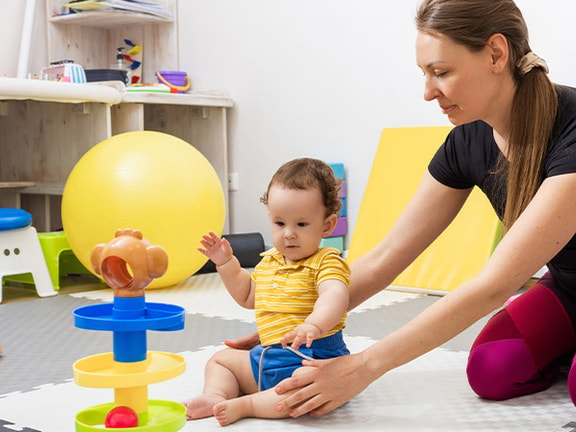5 Benefits of Early Intervention for Children with Cerebral Palsy
November 6, 2024
8 min. read

Cerebral palsy (CP) affects about 1 in 345 children in the United States,1 making it the most common physical disability in childhood. This condition impacts movement, posture, and coordination due to brain damage, which can occur before, during, or shortly after birth. As the child grows, the signs of CP become more noticeable, often affecting activities that most children perform with ease.
Children with cerebral palsy face lifelong challenges that require specialized support. Daily activities such as walking, eating, or playing require assistance. Early detection of CP opens the door for therapies to teach behaviors and skills to improve a childs overall development during the critical window of development and not waiting for deficits. Thanks to advancements in diagnostics, we can now identify cerebral palsy earlier than ever, making intervention possible during the brain's most responsive period.
In this article, we'll explore how early diagnosis and intervention can improve outcomes for children with cerebral palsy, focusing on the key benefits and how they can shape a child's development.
The shift toward early diagnosis
Cerebral palsy used to be typically diagnosed between the ages of two and three, often based on delays in reaching developmental milestones. This wait-and-see approach meant many children missed early opportunities for therapeutic interventions during critical stages of brain development, where intervention could have the most impact.
Tools like MRI and cranial ultrasound, along with early developmental assessments, have made it possible for therapists to diagnose cerebral palsy earlier, sometimes even within the first year of life. This early identification allows therapies to begin sooner, making a significant difference in long-term outcomes by leveraging the brains adaptability during its early stages.
Some of the essential tools for early diagnosis include:
Hammersmith Infant Neurological Examination (HINE): This examination evaluates neurological function in infants between two and 24 months old. When combined with neuroimaging, motor assessments, and a child's medical history, the HINE can help identify early signs of cerebral palsy and provide timely referrals for therapeutic services.
General Movement Assessment (GMA): The GMA further enhances early diagnostic capabilities by assessing the quality and coordination of movements in infants. It involves observing spontaneous, complex movements during the first few months of life, assessing the quality of their general movements (GMs). GMs occur across the entire body and are easily detected between three to five months of age. The absence of normal GMs or the presence of abnormal patterns during this time window could be an early sign of CP. The GMA is highly sensitive for identifying infants at risk for CP and is used in conjunction with other assessments (i.e., MRI, neurological exams) to provide a comprehensive diagnosis.
5 benefits of early intervention
The human brain, especially in its early stages, has remarkable plasticity, meaning it can reorganize itself and form new neural pathways in response to experiences. This ability is vital for children with cerebral palsy because it allows them to adapt and learn motor skills that may have been compromised by brain injury.
Early intervention is key to taking advantage of this critical window. Research on children aged 0 to 2 years with or at high risk of cerebral palsy recommends starting therapies as soon as a high risk of CP is identified to improve motor, cognitive, and social functions.2 So, what specific benefits can we expect when intervention starts early?
1. Improved motor function
Motor deficits are a defining characteristic of cerebral palsy, often manifesting as spasticity (muscle stiffness), dystonia (involuntary movements), or ataxia (balance issues). These challenges can affect a child's ability to perform daily tasks such as walking, grasping objects, or maintaining balance.
Early physical therapy and occupational therapy are equipped to address these challenges by focusing on improving motor function and reducing muscle stiffness. Techniques such as constraint-induced movement therapy (CIMT) and task-specific training have shown great promise in enhancing motor skills by encouraging repetitive, active movements that reinforce neural pathways.
A review on interventions for treating children with cerebral palsy suggests that starting therapy before age two leads to more significant improvements in motor skills compared to starting later. The earlier therapy begins, the greater the potential for the child to achieve functional independence in activities like walking, dressing, or feeding.3
2. Prevention of secondary complications
Delaying intervention can lead to secondary complications such as joint contractures, muscle atrophy, and even orthopedic deformities. These issues arise when muscle stiffness and abnormal movement patterns go unaddressed for extended periods.
Therapies like stretching, strengthening exercises, and the use of assistive devices can help prevent these complications by promoting better posture, muscle control, and healthier movement patterns from an early age. Early speech-language pathology and feeding therapy are also introduced to address speech and feeding difficulties, providing comprehensive support for multiple developmental areas at once.
3. Enhanced cognitive and social development
While cerebral palsy primarily affects motor function, it can also impact a child's cognitive and social development. Limited mobility and motor challenges can reduce opportunities for play, social interaction, and exploration—activities that are essential for cognitive and emotional growth.
Early therapy often includes play-based interventions that target motor skills while also encouraging social engagement, problem-solving, and cognitive development. For example, adaptive toys or modified play environments help children with CP engage with their peers and surroundings, encouraging social interaction and building confidence. Early intervention in these areas promotes independence, allowing children to more fully participate in school, family life, and community activities as they grow.
4. Support for families
Early intervention doesn't only benefit the child—it also helps families and caregivers. Raising a child with cerebral palsy can be emotionally and physically demanding, especially when parents or caregivers feel uncertain about the child's future.
Therapists can play a vital role in guiding families through this journey. Early intervention services provide family-centered care, helping families understand the child's condition, set realistic expectations, and learn strategies for supporting their child's development at home. Families receiving early intervention feel more empowered and better equipped to advocate for their child's needs. These services also connect families with support networks, offering opportunities to share experiences and resources with others facing similar challenges.
5. Improved emotional well-being
Emotional well-being is another area positively impacted by early intervention. Children with cerebral palsy who begin therapy early are often better equipped to manage frustrations that arise from physical limitations. They experience a greater sense of achievement as they develop new skills, which can reduce anxiety and increase self-confidence.
Incorporating therapeutic activities that encourage self-expression can also help children develop emotional resilience. With timely interventions, children are better able to cope with the challenges of cerebral palsy, leading to a more positive emotional and mental outlook as they grow.
Early action for better outcomes
The earlier a child with cerebral palsy receives intervention, the greater their chances for improved outcomes. Early diagnosis and therapy can strengthen motor function, prevent complications, support cognitive and social growth, and provide invaluable help to families.
As healthcare professionals, we have the opportunity to advocate for early screening and intervention, which can significantly change the trajectory of a child's development. Every step taken early sets the stage for a brighter future. To learn more about diagnosis and intervention for cerebral palsy in children, watch my latest Medbridge courses:
Cerebral Palsy in Children: Diagnosis, Presentation, and Evaluation
Treating Cerebral Palsy in Children: School Age to Young Adults
References
Centers for Disease Control and Prevention. (n.d.). Data and statistics for cerebral palsy. CDC. https://archive.cdc.gov/www_cdc_gov/ncbddd/cp/data.html
Morgan, C., Fetters, L., Adde, L., Badawi, N., Bancale, A., Boyd, R. N., Chorna, O., Cioni, G., Damiano, D. L., Darrah, J., de Vries, L. S., Dusing, S., Einspieler, C., Eliasson, A. C., Ferriero, D., Fehlings, D., Forssberg, H., Gordon, A. M., Greaves, S., Guzzetta, A., Novak, I. (2021). Early Intervention for Children Aged 0 to 2 Years With or at High Risk of Cerebral Palsy: International Clinical Practice Guideline Based on Systematic Reviews. JAMA pediatrics, 175(8), 846858. https://jamanetwork.com/journals/jamapediatrics/article-abstract/2780012#google_vignette
Novak, I., Morgan, C., Fahey, M., Finch-Edmondson, M., Galea, C., Hines, A., Langdon, K., Namara, M. M., Paton, M. C., Popat, H., Shore, B., Khamis, A., Stanton, E., Finemore, O. P., Tricks, A., Te Velde, A., Dark, L., Morton, N., & Badawi, N. (2020). State of the Evidence Traffic Lights 2019: Systematic Review of Interventions for Preventing and Treating Children with Cerebral Palsy. Current neurology and neuroscience reports, 20(2), 3. https://link.springer.com/article/10.1007/s11910-020-1022-z
Below, watch Heather Mahnken explain what is cerebral palsy in this brief clip from her Medbridge course "Cerebral Palsy in Children: Diagnosis, Presentation, and Evaluation."






